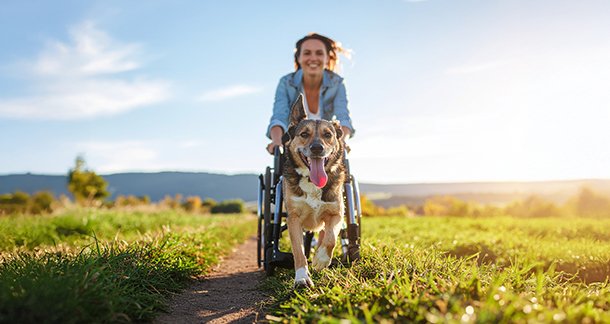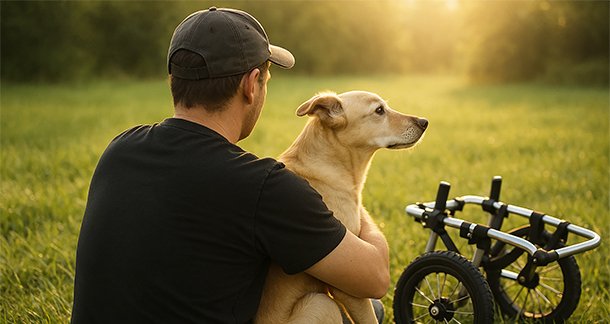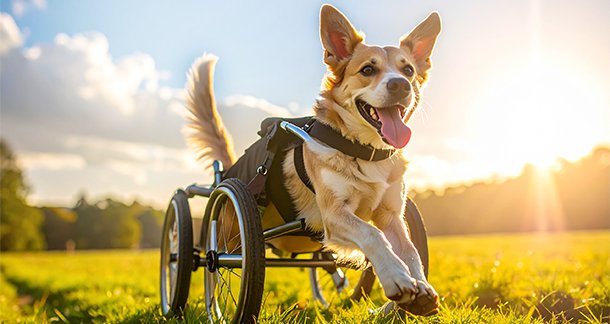Dogs are celebrated for their resilience, loyalty, and unshakable spirit. When a dog is disabled—whether through birth defects, illness, injury, or age, their ability to adapt and find joy in life can be truly inspiring. Yet, caring for a disabled dog requires patience, sensitivity, and an understanding that their world, though different, is still full of possibilities. For many guardians, providing such care becomes one of the most meaningful experiences of their lives, strengthening the bond between human and animal in extraordinary ways.
Disability in dogs can take many forms. Some are born with congenital conditions that limit mobility, while others may lose the use of their legs due to accidents or degenerative diseases. Vision or hearing loss is also common, particularly in aging dogs. Regardless of the specific challenge, what matters most is not what the dog has lost, but how we as caregivers adapt our environments and attitudes to support them. Dogs, unlike humans, do not dwell on what they cannot do. They live fully in the present moment, focusing on the love, comfort, and joy they receive. This perspective is often a powerful reminder to us about resilience and acceptance.
One of the most important aspects of caring for a disabled dog is creating a safe and supportive environment that reduces their frustration and maximizes independence. A dog with mobility issues may need ramps to access beds, couches, or outdoor areas. Smooth, slip-free flooring makes it easier for them to move without risk of injury. For a blind dog, consistency is key; furniture should not be frequently rearranged, and the scent of familiar objects helps them map their surroundings. A deaf dog thrives with visual signals, gentle touch, and routine, proving that communication is possible in many forms. By observing our dogs closely and adapting our spaces, we enable them to navigate their world with dignity.

Beyond the physical environment, disabled dogs require attentive healthcare. Regular veterinary visits help monitor their condition, and specialized treatments such as physiotherapy, hydrotherapy, or acupuncture may improve their quality of life. For some, mobility aids like wheelchairs or harnesses become liberating tools rather than limitations, allowing them to run, explore, and play just like any other dog. The sight of a once-immobile dog bounding happily in a wheelchair is enough to dispel any doubts about their ability to live a joyful, fulfilling life. With the right medical support and daily care, many disabled dogs enjoy lifespans and levels of happiness comparable to their able-bodied companions.
Caring for a disabled dog also demands emotional strength from the human side. It is natural to feel sadness when witnessing a beloved pet struggle with physical limitations, but it is essential to remember that dogs do not measure their worth by their abilities. They measure it through love, attention, and companionship. Guardians often find that their dogs, far from being defined by disability, continue to shower them with affection and zest for life. What may begin as a daunting responsibility often transforms into a profound lesson in empathy, patience, and unconditional love.
The daily routine of living with a disabled dog may involve extra effort -lifting them into the car, cleaning up accidents, or ensuring medication is given on time, but these tasks quickly become second nature. Small adaptations, such as using a supportive sling for bathroom breaks or feeding at consistent times, establish structure and comfort. And in return, the dog continues to offer the same companionship, loyalty, and joy they always have, often with an even greater sense of connection. Many caregivers describe their relationship with a disabled dog as uniquely deep, forged by the trust that comes from overcoming challenges together.
Perhaps the most profound lesson in caring for a disabled dog is the shift in perspective it brings. Dogs do not feel pity for themselves, nor do they long for what they once had. They simply live, embracing each moment with gratitude and courage. Watching a three-legged dog chase after a ball, or a blind dog confidently navigate familiar paths, reminds us that limitations do not define happiness. Their resilience encourages us to focus less on what is missing and more on what remains—love, companionship, and the joy of shared life.

There is also a broader responsibility when it comes to disabled dogs. Too often, they are abandoned or overlooked in shelters because potential adopters fear the challenges of care. Yet those who open their homes to these dogs often discover that the rewards far outweigh the struggles. A disabled dog is not a burden; they are a teacher of compassion, adaptability, and unconditional acceptance. By choosing to care for them, we not only transform their lives but enrich our own in ways we could never have imagined.
In the end, caring for a disabled dog is an act of devotion that goes beyond the routines of feeding and walking. It is about honoring their spirit, adapting to their needs, and cherishing the unique bond that forms in the face of adversity. Disability may change the way a dog moves through the world, but it never diminishes their capacity for love, joy, or loyalty. With patience, understanding, and compassion, disabled dogs can and do live rich, fulfilling lives. And for those fortunate enough to share that journey with them, the experience becomes a lasting testament to the resilience of animals and the boundless power of love.
Would you like me to make this one even more emotionally moving with real-life anecdotes or rescue stories (to touch hearts more), or keep it general and informative like this?
By Sonechka Mishra

